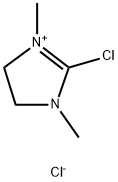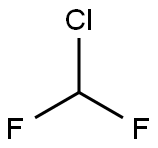2-Chloro-1,3-dimethylimidazolidinium tetrafluoroborate
Synonym(s):CIB
- CAS NO.:153433-26-2
- Empirical Formula: C5H10ClN2.BF4
- Molecular Weight: 220.4
- MDL number: MFCD17976893
- EINECS: 623-751-1
- SAFETY DATA SHEET (SDS)
- Update Date: 2023-04-23 13:52:06

What is 2-Chloro-1,3-dimethylimidazolidinium tetrafluoroborate?
Chemical properties
Colorless to white crystalline powder
The Uses of 2-Chloro-1,3-dimethylimidazolidinium tetrafluoroborate
2-Chloro-1,3-dimethylimidazolium tetrafluoroborate is a reagent for esterification of C-terminal amino acids to Wang resin without racemization and for coupling α,α-dimethyl amino acids; and for preparation of the benzotriazol-1-yloxy derivative, a new coupling reagent. It is used as a reagent for esterification and peptide coupling of sterically hindered amino acids; preparation of efficient diazo-transfer reagents; oxidative insertion for palladium and nickel catalyst synthesis; and preparation of catalysts for use in coupling reactions.
The Uses of 2-Chloro-1,3-dimethylimidazolidinium tetrafluoroborate
Reagent for:
Esterification and peptide coupling of sterically hindered amino acids
Preparation of efficient diazo-transfer reagents
Oxidative insertion for palladium and nickel catalyst synthesis
Preparation of catalysts for use in coupling reactions
Properties of 2-Chloro-1,3-dimethylimidazolidinium tetrafluoroborate
| Melting point: | 175-177 °C(lit.) |
| storage temp. | 2-8°C |
| solubility | acetonitrile: 0.1 g/mL, clear |
| form | Powder or Crystalline Powder |
| color | White to off-white |
| Sensitive | Moisture & Light Sensitive |
| CAS DataBase Reference | 153433-26-2(CAS DataBase Reference) |
Safety information for 2-Chloro-1,3-dimethylimidazolidinium tetrafluoroborate
| Signal word | Warning |
| Pictogram(s) |
 Exclamation Mark Irritant GHS07 |
| GHS Hazard Statements |
H315:Skin corrosion/irritation H319:Serious eye damage/eye irritation H335:Specific target organ toxicity, single exposure;Respiratory tract irritation |
| Precautionary Statement Codes |
P261:Avoid breathing dust/fume/gas/mist/vapours/spray. P264:Wash hands thoroughly after handling. P264:Wash skin thouroughly after handling. P271:Use only outdoors or in a well-ventilated area. P280:Wear protective gloves/protective clothing/eye protection/face protection. P302+P352:IF ON SKIN: wash with plenty of soap and water. P305+P351+P338:IF IN EYES: Rinse cautiously with water for several minutes. Remove contact lenses, if present and easy to do. Continuerinsing. |
Computed Descriptors for 2-Chloro-1,3-dimethylimidazolidinium tetrafluoroborate
| InChIKey | UPLXKEIRISBKRM-UHFFFAOYSA-N |
New Products
Tert-butyl bis(2-chloroethyl)carbamate 4-Methylphenylacetic acid N-Boc-D-alaninol N-BOC-D/L-ALANINOL 3-Morpholino-1-(4-nitrophenyl)-5,6-dihydropyridin- 2(1H)-one Furan-2,5-Dicarboxylic Acid Tropic acid 1,1’-CARBONYLDIIMIDAZOLE DIETHYL AMINOMALONATE HYDROCHLORIDE R-2-BENZYLOXY PROPIONIC ACID 1,1’-CARBONYLDI (1,2-4 TRIAZOLE) N-METHYL INDAZOLE-3-CARBOXYLIC ACID (2-Hydroxyphenyl)acetonitrile 4-Bromopyrazole 5-BROMO-2CYANO PYRIDINE 5,6-Dimethoxyindanone 5-broMo-2-chloro-N-cyclopentylpyriMidin-4-aMine 2-(Cyanocyclohexyl)acetic acid 4-methoxy-3,5-dinitropyridine 2-aminopropyl benzoate hydrochloride 1-(4-(aminomethyl)benzyl)urea hydrochloride diethyl 2-(2-((tertbutoxycarbonyl)amino) ethyl)malonate tert-butyl 4- (ureidomethyl)benzylcarbamate Ethyl-2-chloro((4-methoxyphenyl)hydrazono)acetateRelated products of tetrahydrofuran








You may like
-
 2-Chloro-1,3-dimethylimidazolinium Tetrafluoroborate CAS 153433-26-2View Details
2-Chloro-1,3-dimethylimidazolinium Tetrafluoroborate CAS 153433-26-2View Details
153433-26-2 -
 1975-50-4 98%View Details
1975-50-4 98%View Details
1975-50-4 -
 2-HYDROXY BENZYL ALCOHOL 98%View Details
2-HYDROXY BENZYL ALCOHOL 98%View Details
90-01-7 -
 2-Chloro-1,3-Bis(Dimethylamino)Trimethinium Hexafluorophosphate 221615-75-4 98%View Details
2-Chloro-1,3-Bis(Dimethylamino)Trimethinium Hexafluorophosphate 221615-75-4 98%View Details
221615-75-4 -
 61397-56-6 CIS BROMO BENZOATE 98%View Details
61397-56-6 CIS BROMO BENZOATE 98%View Details
61397-56-6 -
 14714-50-2 (2-Hydroxyphenyl)acetonitrile 98+View Details
14714-50-2 (2-Hydroxyphenyl)acetonitrile 98+View Details
14714-50-2 -
 118753-70-1 98+View Details
118753-70-1 98+View Details
118753-70-1 -
 733039-20-8 5-broMo-2-chloro-N-cyclopentylpyriMidin-4-aMine 98+View Details
733039-20-8 5-broMo-2-chloro-N-cyclopentylpyriMidin-4-aMine 98+View Details
733039-20-8